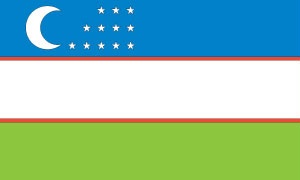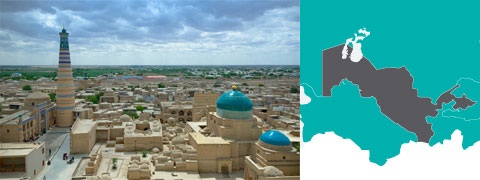Country assessments
Uzbekistan
- Details
- Country assessments
2013 sector transition indicators
Source: EBRD.
Note: Water – Water and wastewater; IAOFS – Insurance and other financial services; PE – Private equity.
Highlights
- Economic growth remains strong. Output grew at the rate of 8.2 per cent in 2012 and 8 per cent in the first half of 2013, on the back of strong domestic demand and large public investment projects.
- Foreign exchange regulations remain restrictive and have been tightened further. The lack of a liberal trade and foreign exchange regime continues to be a major constraint on growth. Further restrictions have also been imposed on exchange transactions by individuals.
- Business environment reforms continued. Following earlier simplification of company registration procedures, tax and licensing procedures, as well as insolvency procedures, have also been streamlined. At the same time, firms remain significantly constrained by foreign exchange restrictions.
Key priorities for 2014
- Implementation of the privatisation programme needs to be accelerated. The programme has the potential to contribute to the modernisation and diversification of the economy. However, its implementation has been slow.
- Liberalisation of the foreign exchange regime would provide a major impetus to private sector development. Increased exchange rate flexibility and easier access to foreign currency are crucial in order to promote entrepreneurial activity and boost cross-border trade.
- Lending practices in the banking sector need to be further commercialised. Shifting away from directed lending at preferential rates towards commercial lending would help move towards a more efficient allocation of scarce capital resources throughout the economy.
Macroeconomic performance
Uzbekistan’s economy continues to grow at a rate of around 8 per cent. GDP growth reached 8.2 per cent in 2012 – broadly unchanged from the previous year – and 8 per cent year-on-year in the first half of 2013. Growth was driven mainly by high government spending, in the form of large wage and pension increases, and scaled-up public investment. Despite growing expenditure, the fiscal balance remained firmly in surplus. Growing remittances inflows also contributed to strong domestic demand. The current account overall recorded a sizeable surplus, although this may be attributable, in part, to restrictions on foreign exchange transactions limiting imports.
High inflation has persisted. Consumer prices have been rising at a rate of around 10 per cent, owing to more expensive food, increases in administrative prices, an expansionary fiscal stance, accommodating monetary policy and continued depreciation of the currency against the US dollar (at a rate of around 8 per cent per annum). Following large-scale balance sheet restructuring in 2011-12, the banking sector outlook remains stable, under the assumption of favourable growth prospects and continued state support. All banks are currently audited by international agencies under the International Financial Reporting Standards.
Economic growth is expected to remain strong in 2013 and in the medium term, driven by commodities. However, the weak business environment severely constrains private sector development, investment and growth potential of the economy in the longer term. In particular, restrictions on foreign currency operations remain in place and severely constrain private sector development.
Major structural reform developments
The economy remains heavily dependent on commodities. Natural resources and closely related products, including gas, gold, cotton and agricultural products, account for around 85 per cent of Uzbekistan’s total exports. Exports have also become more concentrated in geographical terms, with Russia, China and Turkey being the top destinations. The state continues to play a dominant role in the economy. Progress under the recently renewed privatisation programme has been very limited.
External trade and foreign exchange remain subject to various restrictions. These restrictions include delays in currency conversion for imports, restrictions on cash and foreign exchange availability, a restrictive trade policy and the application of state procurement quotas for cotton and wheat. The absence of a liberal trade and foreign exchange regime continues to be a major constraint with respect to both foreign investment and private sector development. In February 2013 the Central Bank of Uzbekistan introduced further restrictions on access to foreign exchange by individuals, effectively limiting exchange operations to non-cash transactions. This measure was advocated as a means of curtailing the illegal circulation of foreign currency in the retail and service sectors.
The business climate remains very difficult, notwithstanding recent reforms. Uzbekistan ranked one hundred and forty-sixth of 189 countries in the World Bank 2014 Doing Business Report, scoring poorly in most components of the ranking. However, it recently made significant improvements in the areas of starting a business, access to credit and resolving insolvency; in particular, new limits for insolvency proceedings have been introduced. In addition, companies have been allowed to continue operations during insolvency proceedings. These improvements resulted in Uzbekistan moving up 24 positions over two years, relative to its ranking in the 2012 Doing Business report. Accounting rules for small enterprises were further simplified in August 2013.
Uzbekistan started the pilot development of a shale oil field. Drilling for shale oil started at the Sangruntau field in the northern Navoi district as part of a US$ 600 million investment. The project seeks to achieve production of 8 million tonnes of shale oil and 1 million tonnes of oil products annually. In addition, the pilot has broader regional significance, as a test of the viability of the shale oil in Central Asia. Up to 60 per cent of Uzbekistan’s territory is considered promising in this regard, and the shale oil extraction technology could reverse the rapid decline in oil production that has occurred over the last decade, and which has turned Uzbekistan from a net oil exporter to a net importer.
Further steps are being taken to diversify gas export routes. A gas purchase and transmission agreement with Gazprom – the largest extractor of natural gas in Russia – has been renewed, but is narrower in scope than the preceding Agreement on Strategic Cooperation, which covered the period 2003-12. A working group on a new strategic cooperation agreement has been established. At the same time, Uzbekistan has announced plans to more than double its gas exports to China in the coming years.













